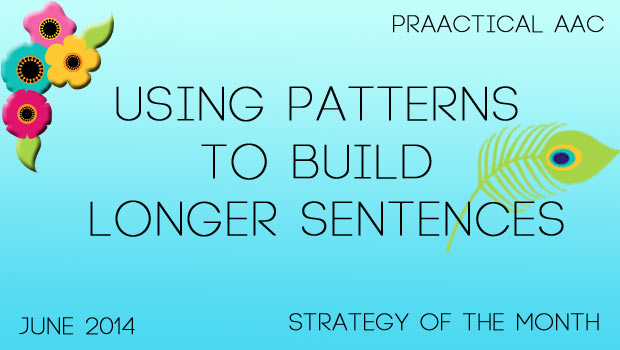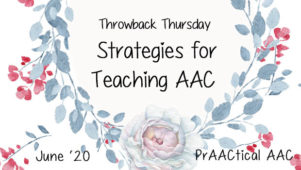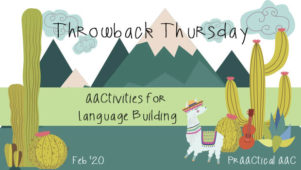Strategy of the Week: Using Patterns to Build Longer Sentences

Throughout the month, we’ve been talking about building sentence length and complexity. We’ll end the month with a concept that applies to both beginning communicators and those with more complex language skills.
Human beings are pattern-seekers. We notice similarities and distinctions, and compare things that are new to us to things we already know about. As we go through our lives, we draw on our pattern-seeking skills to learn about and understand the world. How can we use this intrinsic trait to help us in teaching language to AAC learners?
- Consider patterns when choosing your targets: Increasing sentence length is a broad goal that gives us lots of flexibility in how we design our intervention. We can lengthen sentences by adding descriptors, temporal terms, conjunctions, embedded clauses, and more. Within each category, there are many options. For a beginning communicator, we might teach descriptors related to appearance (e.g., size, color, shape). For a more advanced language user, we might focus on verb phrases. Either way, we can maximize learning by considering how we can use patterns in our implementation.
- Use visual supports: Many AAC learners do best when we make language visible. Make the pattern obvious with visual supports. The Fokes Sentence Builder was our first introduction to this sort of thing. It was a color-coded template for creating sentences that have a predictable pattern (e.g., The noun is verb+ing. The noun is verb+ing + prepositional phrase). We love the Boardmaker templates using a modified Fitzgerald Key for the basic schema, who/what doing, which/where by Marcia Sterner and the AT Team at OCPS.
- Provide repetition with variety: For many AAC learners, new language concepts really sink in when we provide instruction in multiple contexts, with varied materials, and different partners. Find ways to model target sentence structures throughout the day, calling attention to them when appropriate. Elicit them in a variety of structured activities, daily routines, and casual conversations.
Do you have ways of building longer, more complex sentences that we haven’t talked about? We’d love to hear your ideas.
Filed under: Strategy of the Month
Tagged With: language intervention, sentence length, sentence structures
This post was written by Carole Zangari




